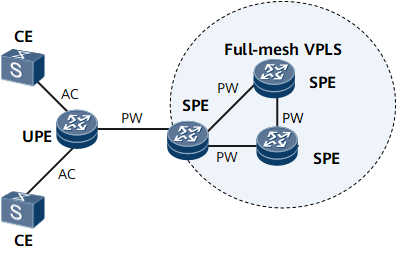HVPLS
Definition
In a VPLS solution, all PEs that provide VPLS services must be fully meshed using label switched paths (LSPs). N x (N – 1)/2 PWs must be established using signaling protocols between PEs for each VPLS service. The preceding solution cannot be applied on a large scale, because the PEs that provide virtual circuits (VCs) must copy packets, and each provider edge (PE) must broadcast the first unicast, broadcast and multicast packets to all the peers. This is a waste of bandwidth. In this situation, you can use hierarchical connections to reduce the burden of signaling protocols and packet replication and apply VPLS on a large scale.
The core of hierarchical virtual private LAN service (HVPLS) is to hierarchize the network. The network of each level is fully meshed. Devices of different levels are connected using PWs and forward data to each other without complying with the split horizon principle.
Purpose
HVPLS is introduced to cope with the problem of VPLS full mesh and enhance the expansibility of VPLS networks.
Principles
Figure 1 shows a basic HVPLS model.
In a basic HVPLS model, PEs can be classified into the following types:
User-end PE (UPE): A customer convergence device that directly connects to CEs. A UPE needs to be connected to only one PE on a full-mesh VPLS network. A UPE supports routing and MPLS encapsulation. If a UPE connects to multiple CEs and possesses the basic bridge function, frame forwarding is performed only on the UPE. This implementation reduces the burden on SPEs.
SPE: A device that connects to UPEs and is located in the core of a full-mesh VPLS network. An SPE connects to all the devices on a full-mesh VPLS network.
From the perspective of an SPE, a UPE functions like a CE. In data forwarding, an SPE uses the PW established between itself and a UPE as an AC. The UPE adds double MPLS labels to packets sent by CEs. The outer label is an LSP label that is switched when a packet passes through devices on the access network. The inner label is a VC label that identifies a VC. The inner label remains unchanged when a packet is transmitted along an LSP. After receiving double-tagged packets, an SPE directly removes the outer label, a statically configured public network label and determines the VSI which the AC accesses based on the inner label.
